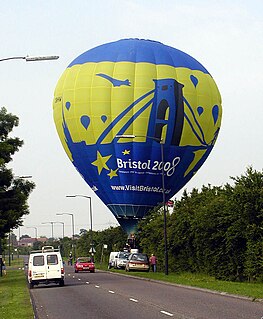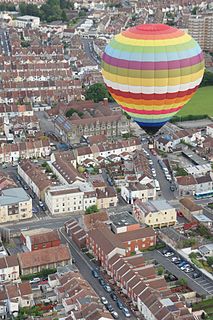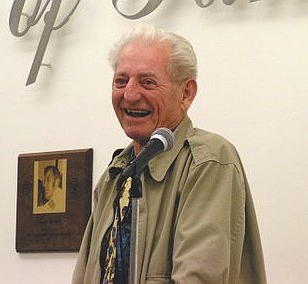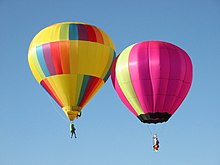
A hot air balloon is a lighter-than-air aircraft consisting of a bag, called an envelope, which contains heated air. Suspended beneath is a gondola or wicker basket, which carries passengers and a source of heat, in most cases an open flame caused by burning liquid propane. The heated air inside the envelope makes it buoyant, since it has a lower density than the colder air outside the envelope. As with all aircraft, hot air balloons cannot fly beyond the atmosphere. The envelope does not have to be sealed at the bottom, since the air inside the envelope is at about the same pressure as the surrounding air. In modern sport balloons the envelope is generally made from nylon fabric, and the inlet of the balloon is made from a fire-resistant material such as Nomex. Modern balloons have been made in many shapes, such as rocket ships and the shapes of various commercial products, though the traditional shape is used for most non-commercial and many commercial applications.

Cameron Balloons is a company established in 1971 in Bristol, England, by Don Cameron to manufacture hot air balloons. Cameron had previously, with others, constructed ten hot air balloons under the name Omega. Production was in the basement of his house, moving in 1972 to an old church in the city. In 1983 Cameron Balloons moved into its current premises in the former Robinsons paper bag/printing factory. In 1989 the company received the Queen's Award for Export.

In aeronautics, a balloon is an unpowered aerostat, which remains aloft or floats due to its buoyancy. A balloon may be free, moving with the wind, or tethered to a fixed point. It is distinct from an airship, which is a powered aerostat that can propel itself through the air in a controlled manner.

Paul Edward Yost was the American inventor of the modern hot air balloon and is referred to as the "Father of the Modern Day Hot-Air Balloon." He worked for a high-altitude research division of General Mills in the early 1950s until he left to establish Raven Industries in 1956, along with several colleagues from General Mills.

Donald Louis Piccard was a Swiss-born American balloon pioneer, promoter, innovator, designer, builder, and pilot.

Lindstrand Balloons was a manufacturer of hot air balloons and other aerostats. The company was started by Swedish-born pilot and aeronautical designer Per Lindstrand in Oswestry, England, as Colt Balloons in 1978. Lindstrand Balloons was known for its leading-edge engineering, which included sophisticated testing and production facilities.

Hot air ballooning is the activity of flying hot air balloons. Attractive aspects of ballooning include the exceptional quiet, the lack of a feeling of movement, and the bird's-eye view. Since the balloon moves with the direction of the winds, the passengers feel absolutely no wind, except for brief periods during the flight when the balloon climbs or descends into air currents of different direction or speed. Hot air ballooning has been recognized by Fédération Aéronautique Internationale (FAI) as the safest air sport in aviation, and fatalities in hot air balloon accidents are rare, according to statistics from the National Transportation Safety Board (NTSB).
Per Lindstrand is a Swedish aeronautical engineer, pilot, adventurer and entrepreneur. He is particularly known for his series of record-breaking trans-oceanic hot air balloon flights and, later, attempts to be the first to fly a Rozière balloon around the Earth – all with British entrepreneur, Sir Richard Branson. He is also the founder of eponymous Lindstrand Balloons hot air balloon manufacturer based in Oswestry, England.

An observation balloon is a type of balloon that is employed as an aerial platform for intelligence gathering and artillery spotting. Use of observation balloons began during the French Revolutionary Wars, reaching their zenith during World War I, and they continue in limited use today. Synonyms include espionage balloon, reconnaissance balloon, or surveillance balloon.

Virgin Balloon Flights, with headquarters in Telford, Shropshire, began flying hot air balloons in 1994 and its passengers are still flown in red and white balloons with the Virgin Group logo on the side of the balloon.

Julian Nott was a British balloonist who later lived in Santa Barbara, California. He was known for his record-setting achievements. Nott set 79 world ballooning records and 96 British aviation records. He developed balloons for flights to Solar System destinations, particularly Titan. He flew a working prototype Titan balloon at minus 175 Celsius, approximately the temperature of Titan's atmosphere.

The history of ballooning, both with hot air and gas, spans many centuries. It includes many firsts, including the first human flight, first flight across the English Channel, first flight in North America, and first aircraft related disaster.
Georgy (Yegor) Alekseyevich Prokofiev was a Soviet Air Forces balloonist who coordinated a military stratospheric balloon program in 1931–1939. On September 30, 1933, USSR-1 under Prokofiev's command set an unofficial world altitude record of 18,501 metres (60,699 ft).

FireFly Balloons is an American hot air balloon manufacturer that started as The Balloon Works (TBW) in 1972 in Statesville, NC. The company is one of the oldest hot air balloon manufacturers in the United States, behind Raven Industries, SEMCO and Piccard Balloons. The origins of the company's designs can be traced to the work of Tracy Barnes in the late 1960s.
Raven Industries, Inc. is an American company that manufactures precision agriculture products, high-altitude balloons, plastic film and sheeting, and radar systems. The company was founded in 1956. Their headquartered in Sioux Falls, South Dakota. Stock in the company was traded on Nasdaq until 2021 when it was acquired by CNH Industrial.

Dominic Michaelis was an Anglo-French architect, inventor, and solar energy advocate.

On 7 January 2012, a scenic hot air balloon flight from Carterton, New Zealand, collided with a high-voltage power line while attempting to land, causing it to catch fire, disintegrate and crash just north of the town, killing all eleven people on board.
The Cameron D-96 was the first hot air airship, a powered, steerable lighter-than-air craft carrying two or three crew marrying the elongated envelope of an airship with the externally localized heat source of a modern hot air balloon. It was designed and built in the UK and first flown in 1973.

Eleanor Vadala is an American chemist, materials engineer and balloonist. She became director of research and development at the Naval Air Development Center in Pennsylvania, where she helped to develop light synthetic materials for use in aircraft. One of her jobs was the testing of fabric in existing balloons to ensure they could be used safely.

The Balloon Federation of America (BFA) is a 501c3 non-profit group for the advancement of lighter-than-air aviation which includes hot air and gas balloons. Founded in 1960, located in Indianola, Iowa. The BFA partners with the National Balloon Museum to induct outstanding individuals into the United States Ballooning Hall of Fame. The Federation presents multiple awards including the Ed Yost Master Pilot Award and the National Crew Person Award. The BFA facilitates balloon events by providing advice and guidance on FAA compliance.
















